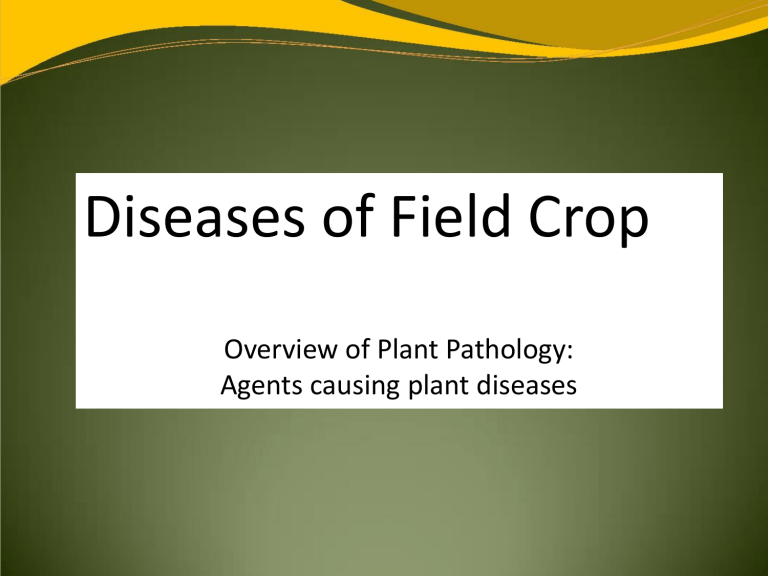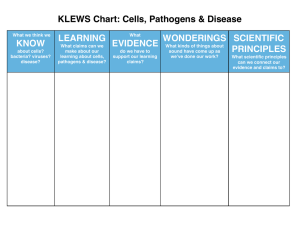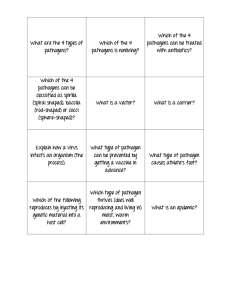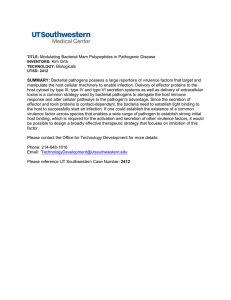
Diseases of Field Crop Overview of Plant Pathology: Agents causing plant diseases PLANT DISEASES (PDs) • PD is an impairment that interrupts or modifies its vital functions. • can also be defined as “any problem with the plant leading to a reduction in yield or appearance”. • Many PDs are caused by “pathogens”, • PD is a harmful deviation from normal functioning of physiological processes. CLASSIFICATION OF PATHOGENS CLASSIFICATION OF PDs BASED ON CAUSAL AGENTS PLANT DISEASE NONINFECTIOUS INFECTIOUS NON INFECTIOUS PDs • • • No association with any pathogen so they cannot be transmitted from an infected plant to a healthy one. Mostly due to improper environmental conditions of soil and air & by mechanical influences on plants. Examples: 1)Low/high temperature, 2) unfavourable oxygen levels , 3) unfavourable water levels, 4) hail , 5)wind, 6)air pollution toxicity etc. High temperature Unfavourable Oxygen levels Unfavourable Water levels Hail Air Pollution Toxicity Lightning Injury Wind Damage INFECTIOUS PLANT DISEASES • caused by pathogenic organisms or viruses under a set of environmental conditions. • Fungi, bacteria, viruses, nematodes & even some plants can be pathogens. • They obtain nutrients, water & everything from their host. • Fungal & viral pathogens causes many plant diseases; bacterial & nematode pathogens cause a few. • Some pathogens can infect several kinds of plants; others require a specific type of host. • Pathogens such as fungi & bacteria differ in their ability to survive, spread & reproduce. Infectious plant diseases. From left to right, top row: tomato mosaic virus, downy mildew of lettuce, bacterial blight of cauliflower, rye ergot, middle row: potato spindle tuber viroid (William M. Brown Jr, amended), lettuce bacterial blight, mixed viral infection on the ramson (cucumber mosaic virus, tobacco rattle virus, tobacco mosaic virus), Septoria blight of celery; bottom row: Fusarium blight of dill, onion rust, black rot (alternariosis) of carrots, and tomato leaf curl virus CONDITIONS NECESSARY FOR PATHOGENIC DISEASES In order for a pathogenic plant disease to occur, three conditions must be met: 1. The host plant must be susceptible. 2. An active, living pathogen must be present. 3. The environment must be suitable or favorable for disease development. All three factors must occur simultaneously. If one factor is absent or unfavourable , disease does not occur. The more the circles overlap, the more severe will be the disease. Environmental factors such as temperature, light, or moisture can accentuate diseases. DISEASE CYCLE • The sequence of events from a pathogen’s survival to plant disease development and back to pathogen cycle is called the “disease cycle”, or the pathogen’s life history. • By understanding the disease cycle – chain of events that contribute to a disease – we can find the weakest links and take measures to break the cycle. • Most pathogens must survive a period of adverse conditions , usually winter , when they do not actively cause disease. • The host plant is infected or continues to be infected by pathogen’s overwintered disease-transmitting substance, inoculum, in the spring. monocyclic (yellow) and polycyclic (yellow and blue) fungi. SYMPTOMS OF FUNGAL DISEASES 1) Mildews : White , grey ,brownish ,or purplish patches of varying sizes on leaves , herbaceous stems or fruits. Powdery Mildew Downy mildews 2) Rusts: relatively small pustules of spores , usually breaking through the host epidermis. Rusts 3) Smuts: In plant diseases known as smuts, the affected parts of the plant show a purplish black or black dusty mass. 4) White blisters: White blister-like pustules which break open & expose powdery mass of spores. Smuts White Blisters 5) Scab : Scab refers to a roughened or crest-like lesion or to a freckled appearance of a diseased organ. 6) Sclerotia : • Sclerotium is a compact, often hard mass of dormant fungal mycelium. • Sclerotia are most often black. • They may be sometimes buff or dark brown or purplish in color. 7) Blotch : It is a superficial growth giving the fruits a blotched appearance as in sooty blotch & fly-speck disease of apple fruits. Blotch 8)Fruiting bodies: They are large, fleshy or woody, spore bearing structures, developed by woodrotting fungi. 9) Tar spots : These are somewhat raised, black-coated fungal bodies with the appearance of a flattened drop of tar on the leaf. Tar spots SYMPTOMS OF BACTERIAL DISEASES 1) Exudations: In several bacterial diseases, such as bacterial blight of paddy & fire blight of pome fruits, masses of bacteria ooze out from the affected organ & appear on the surface as drops or smears. Fire Blight Exudations SYMPTOMS DUE TO SOME EFFECT ON THE HOST PLANT • Diseases cause marked changes in the form, size, color, texture, attitude or habit of the plant or some of its organs. • Two or more of these changes may occur in the same host organ as effects of the same disease. • These changes result from the presence & activity of some pathogenic organisms & also from the reaction of the host tissues against them. • The pathogen may be found within the affected tissues or upon the surface. 1) Colour Changes : Discoloration of the plant , or change of colour from normal colour. Example : 1) Chlorosis : Green →Yellow 2) Albinism : Green →Colourless 3) Chromosis : Green →Red , purple or orange Chlorosis 2) Overgrowth: Abnormal increase in the size of one or more organs of the plant or certain portions of it. This is usually the result of stimulation of the host tissues for excessive growth. It may be due Hyperplasia or Hypertrophy. Hyperplasia: Abnormal increase in the size of a plant organ due to increase in the number of cells. Hypertrophy: Increased size of the organ due to increased size of cells. 3) Atrophy or hypoplasia: Here inhibition of growth occurs, resulting in stunting or dwarfing. Dwarfing results from atrophy or hypoplasia. Atrophy is degeneration of cells and organs, where as hypoplasia is the abnormal decrease in the size of cells & organs. • 4) Necrosis : It is the death of tissues & organs due to parasitic activity. Necrotic symptoms are highly variable. Necrosis 5)Wilts : It is the drying or wilting of the entire plant. The leaves & other green or succulent parts lose their turgidity, becomes f laccid &droop. This effect is usually seen first in some of the leaves. 6) Die-back : It is the dying of plant organs, especially stem or branches , backwards from the tip. PLANT DISEASE CONTROL Control measures Exclusion Eradication Protection Immunization 1)EXCLUSION This method includes quarantines, inspections & certification. These techniques prevent movement of diseased plant material into a particular country, state , or geographical area where the disease doesn’t exist. E.g.: Agricultural Inspection Station in California. Quarantines are regulations forbidding sale or shipment of plants or plant parts. 2) AVOIDANCE If a disease doesn’t occur in your area , you may be able to avoid its development on your plants. Planting certified , virus-free stock is a good way to avoid viral diseases. Root rots can be avoided by not planting in heav y poorly drained soils. Delaying planting until soils are dry & warm can avoid damping-off of vegetable seeds. Avoid wounding plants when pruning or using equipment , as wounds can be the entry points for pathogens or can weaken the plant so that it cannot defend itself. Use good horticultural practices, such as proper fertility , pruning , watering to ward off infections. 3)ERADICATION Rotation , sanitation , elimination of alternate hosts , chemical application & heat treatment are eradication methods , when a plant is infected or an area is infested with a pathogen. Crop Rotation : It is common in both commercial & home gardens , involving planting of different crops in a given location each year. It can reduce soil populations of fungi & nematodes. I. To practice rotation you need to know the pathogen & which plants are its hosts. II. Rotation works only if you plant non-hosts. SANITATION: Removing plant debris , is important where pathogens may overwinter. I. Rake leaves , remove rotted fruit , pick up old vines & prune out dead wood or canes. II. Dispose of the debris by burning burying or hot composting. ELIMINATION OF ALTERNATE HOSTS : Certain pathogens complete their life cycle on two or more hosts (E.g.: Rusts) only one of which may be a crop plant. Eliminating alternate hosts may reduce pressure from these diseases , Since such pathogens cannot complete their life cycle without the alternate host. Infections & Infestations can be prevented by certain chemicals. Some fungicides also have “kickback” action. Certain fungi & nematodes can be reduced by fumigating or steam sterilizing the soil. Heat treatment is usually used to eliminate viruses from propagation material. Steam treatment of soil Solarization PROTECTION It means treating a healthy plant before it becomes diseased, both chemical & biological means are available. Eg: Use of a bacterium as a protection from Crown Gall disease. Chemical Protection is a common technique which involves Fungicides. RESISTANCE • Resistance, immunity, tolerance & susceptibility are the terms that describe a plant’s genetic makeup & its reaction to plant pathogens. • Resistance & its opposite , susceptibility, are levels or degrees of a plant’s reaction to a pathogen. • If a plant never becomes diseased , the term immune is used. • The word tolerant describes a plant which may become diseased yet grow much like a healthy plant. • Planting resistant cultivars is the easiest means of disease control. THANK YOU




